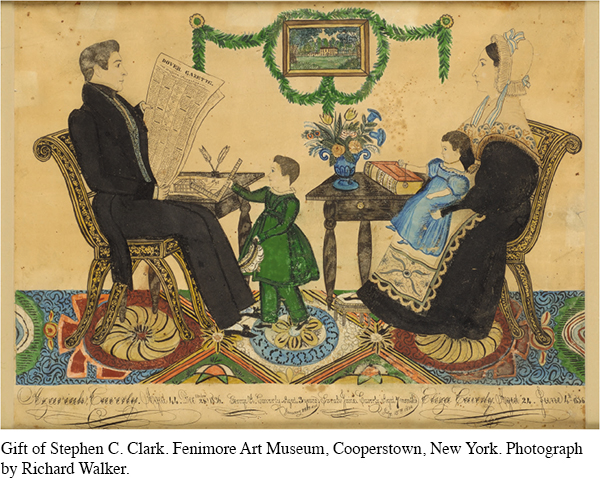The Family and Separate Spheres
The centerpiece of new ideas about gender relations was the notion that husbands found their status and authority in the new world of work, leaving wives to tend the hearth and home. Sermons, advice books, periodicals, and novels reinforced the idea that men and women inhabited separate spheres and had separate duties. “To woman it belongs . . . to elevate the intellectual character of her household [and] to kindle the fires of mental activity in childhood,” wrote Mrs. A. J. Graves in a popular book titled Advice to American Women. For men, by contrast, “the absorbing passion for gain, and the pressing demands of business, engross their whole attention.” In particular, the home, now said to be the exclusive domain of women, was sentimentalized as the source of intimacy, love, and safety, a refuge from the cruel and competitive world of market relations.
Some new aspects of society gave substance to this formulation of separate spheres. Men’s work was undergoing profound change after 1815 and increasingly brought cash to the household, especially in the manufacturing and urban Northeast. Farmers and tradesmen sold products in a market, and bankers, bookkeepers, shoemakers, and canal diggers earned regular salaries or wages. Furthermore, many men now worked away from the home, at an office or a store.
A woman’s domestic role was more complicated than the cultural prescriptions indicated. Although the vast majority of married white women did not hold paying jobs, their homes required time-consuming labor. But the advice books treated housework as a loving familial duty, thus rendering it invisible in an economy that evaluated work by how much cash it generated. In reality, many wives contributed to family income by taking in boarders or sewing for pay. Wives in the poorest classes, including most free black wives, did not have the luxury of husbands earning adequate wages; for them, work as servants or laundresses helped augment family income.
Idealized notions about the feminine home and the masculine workplace gained acceptance in the 1830s because of the cultural ascendancy of the commercialized Northeast, with its domination of book and periodical publishing. Men seeking manhood through work and pay could embrace competition and acquisitiveness, while women established femininity through dutiful service to home and family. This particular formulation of gender difference helped smooth the path for the first generation of Americans experiencing the market revolution, and both men and women of the middle classes benefited. Men were set free to pursue wealth, and women gained moral authority within the home. Beyond white families of the middle and upper classes, however, these new gender ideals had limited applicability. And new voices like those of the Grimké sisters challenged whether “virtue” and “duty” had separate masculine and feminine manifestations. Despite their apparent authority in printed material of the period, these gender ideals were never all-pervasive. [[LP Photo: P11.08 The Caverly Family at Home, 1836/

Understanding the American Promise 3ePrinted Page 301
Section Chronology